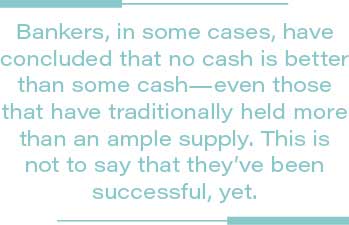By Jim Reber, ICBA Securities

It may be a gross oversimplification to say this, but in many ways, community banks deal with their favorite broker the same way you deal with your dry cleaner. For one thing, there’s repeat business; we’re not a durable goods vendor that you visit every three years. For another, fixed-income brokers sell a set of relatively fungible products. For another, since there are plenty of us out there, we’re obliged to stay pretty much on-market with our prices.
Over time, a business relationship develops, much of which is a matter of convenience for the busy portfolio manager. And out of this relationship comes dialogue. In 2020, the dialogue has gone places it had not yet visited. So, as the year ends and hopefully the COVID-19-dominated headlines begin to recede, I’d like to recount some questions and comments we’ve heard for the first time this year.
“I need to get rid of this cash.”
To be sure, there has been an avalanche of liquidity that arrived on the doorstep of virtually all community banks this year. We could compose a Venn diagram using loan demand, Fed quantitative easing, investor flight-to-quality and of course, the Treasury’s Paycheck Protection Program. All of these conspired to stuff banks full of money, which yields next to nothing.
Bankers, in some cases, have concluded that no cash is better than some cash — even those that have traditionally held more than an ample supply. This is not to say that they’ve been successful, yet. As of Sept. 30, nearly 25% of all bank assets was “liquidity,” meaning due from + unpledged securities + fed funds sold. This is the highest level in about a decade and, in absolute dollars, an all-time high.

“What’s wrong with 30-year mortgage paper?”
Portfolio managers have traditionally run, not walked, from the prospect of buying a mortgage-backed security (MBS) that has a 30-year life. In fact, by doing so, they are shunning around 88% of that market. Usually, the reasons are sound; these long-stated final bonds produce little current cash flow and have longer-than-preferred average lives.
In this market however, the long maturities can in fact offer some stability to cash flow that shorter maturities can’t. Attendant to this is that many of the 30-year pools can be quite large, “TBA-eligible” pools that the Fed is buying for its own balance sheet. So, a suggestion can be made that Jay Powell and associates are price-supporting this segment of the mortgage market.
“I think we need to do an interest rate swap.”
This is a perfect example of the unique challenges facing community banks in this pandemic. Many thousands of balance sheets are now staring down record low yields in which to invest or lend and net interest margins (NIMs) that are narrow and narrowing. We can demonstrate that margins can be improved or at least solidified by executing interest rate swaps on either side of the ledger.
One example is a bank buying a long fixed-rate municipal bond and instantly turning it into a floating rate instrument. Thanks to the relatively flat yield curve, one can convert a 10-year duration into a 90-day duration and surrender today only about 50 basis points. In turn, that could free up other opportunities to lock in some longer fixed-rate assets to stanch the bleeding in NIM.
“Remind me why we don’t buy revenue bonds.”
Traditionally, portfolio managers have preferred general obligation (GO) municipals over revenue bonds because GOs are paid off through property taxes, and not a stream of dedicated income from some type of activity. It’s been a good bet over the years, as there have been virtually no defaults of muni issues that are both rated and GO.
In a year like this, revenue bonds can be worth a look, if the source of revenue is an essential service. Yields on “revs” are usually higher than for a similarly rated GO, and we know that incremental yield is a precious commodity today. So, ask your broker to show you a revenue bond that is secured by water or sewer fees, school building leases, or utilities. You may like what you see.
“It’s time to extend my portfolio.”
To most community bankers, short means good. This is a vestige of their experience with a collection of bonds that are worth 93 cents on the dollar thanks to aggressive tightening by the Fed (circa 2000) or furrowed brows from regulators concerning extension risk and exposure to rising rates.
Not today: rate exposure has clearly flipped. Most banks need to actively manage their maturities back to their intended objectives. This can be done in several ways and most directly by buying “out on the curve.” Certain high-quality products with sufficient length can produce yields approaching 2%. Constant attention to the maintenance of the community bank’s duration is yet more dialogue that portfolio managers will be having with their dry cleaners. Or, make that investment brokers.

Jim Reber (jreber@icbasecurities.com) is president and CEO of ICBA Securities, ICBA’s institutional, fixed-income broker-dealer for community banks.
This story appears in Issue 1 2021 of the In Touch Magazine.






